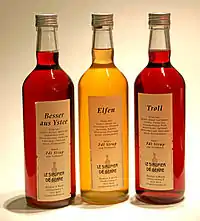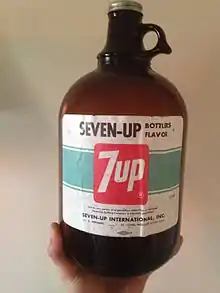Syrup
In cooking, a syrup (less commonly sirup; from Arabic: شراب; sharāb, beverage, wine and Latin: sirupus)[1] is a condiment that is a thick, viscous liquid consisting primarily of a solution of sugar in water, containing a large amount of dissolved sugars but showing little tendency to deposit crystals. Its consistency is similar to that of molasses. The viscosity arises from the multiple hydrogen bonds between the dissolved sugar, which has many hydroxyl (OH) groups.
.jpg.webp)
Culinary syrup

There are a range of syrups used in food production, including:
- Agave syrup, made from agave stem
- Cane syrup, made from sugar canes
- Chocolate syrup
- Corn syrup
- Glucose syrup
- Golden syrup, a by-product of refining crystallized sugar
- High fructose corn syrup, widely used in the US[2][3][4][5]
- Maple syrup
Common syrups

A variety of beverages call for sweetening to offset the tartness of some juices used in the drink recipes. Granulated sugar does not dissolve easily in cold drinks or ethyl alcohol. Since the following syrups are liquids, they are easily mixed with other liquids in mixed drinks, making them superior alternatives to granulated sugar.
Inverted sugar syrup
Inverted sugar syrup, also known as simple syrup, is a basic sugar-and-water syrup. It is used by bartenders as a sweetener to make cocktails, and as a yeast feeding agent in ethanol fermentation.
The ratio of sugar to water is 1:1 by volume for normal simple syrup, but can get up to 2:1 for rich simple syrup.[6] For pure sucrose the saturation limit is about 5:1 (500 grams (18 oz) sucrose to 100 millilitres (3.5 imp fl oz; 3.4 US fl oz) water).
Demerara syrup
Combining demerara sugar, a type of natural brown sugar, with water in this process produces demerara syrup. Sugar substitutes such as honey or agave nectar can also be used to make syrups. Spices can be added to the ingredients during the process, resulting in a spiced simple syrup.
Flavored syrup
Flavored syrups are made by infusing simple syrups with flavouring agents during the cooking process. A wide variety of flavouring agents can be used, often in combination with each other, such as herbs, spices, or aromatics. For instance, syrupus aromaticus is prepared by adding certain quantities of orange flavouring and cinnamon water to simple syrup. This type of syrup is commonly used at coffee bars, especially in the United States, to make flavoured drinks. Infused simple syrups can be used to create desserts, or, to add sweetness and depth of flavour to cocktails.
Gomme syrup
Gomme syrup (or gum syrup; gomme is French for "gum") is inverted sugar syrup added with gum arabic. Gomme syrup is made with the highest ratio of sugar to water possible, while the gum arabic prevents the sugar from crystallizing and adds a smooth texture.
It is an ingredient commonly used in mixed drinks, and as a sweetener for iced coffee in Japan.
Production
Syrups can be made by dissolving sugar in water or by reducing naturally sweet juices such as cane juice, sorghum juice, or maple sap. Corn syrup is made from corn starch using an enzymatic process that converts it to sugars.
A must weight-type refractometer is used to determine the sugar content in the solution.
For fermentation
Syrup is used to feed microbiological life. Syrup consists of carbohydrates and water. Cold drinking water (from tap water (even without a faucet aerator), lakes, etc.) can hold more dissolved oxygen than warm water.
Saccharomyces cerevisiae, is an important yeast in ethanol fermentation and winemaking. S. cerevisiae is able to grow both in the presence and absence of oxygen,[7] but the fermentation rate increases during the stationary phase in the presence of oxygen.[8]
Examples of hydrolyzed sugars with high water ratio used in fermentation:
- Inverted sugar syrup
- Fermented water
- Kombucha is produced by fermenting sugared tea using a symbiotic culture of bacteria and yeast (SCOBY).
- Winemaking kits: Cheap winemaking kits usually instruct that the grape juice should be diluted sucrose (bought separately) should be dissolved in water.
However, concentrated syrups contain little water and thus have little impact in terms of oxygen. For example, glucose syrup containing over 90% glucose is used in industrial fermentation.[9]
See also
- List of syrups
- Kithul treacle
- Meringue
- Sharbat
- Squash (drink)
- Stevia
- Sugar beet syrup
- Torani
- Vincotto
- Vino cotto
References
- Online Etymology Dictionary: syrup Archived 2012-08-21 at the Wayback Machine
- Tyler James Wiltgen (August 2007). "An Economic History of the United States Sugar Program" (PDF). Archived (PDF) from the original on 2015-02-09. Masters thesis.
- "U.S. Sugar Policy". SugarCane.org. Archived from the original on 2015-02-11. Retrieved 2015-02-11.
- "Food without Thought: How U.S. Farm Policy Contributes to Obesity". Institute for Agriculture and Trade Policy. November 2006. Archived from the original on 2007-09-27.
- "Corn Production/Value". Allcountries.org. Archived from the original on 2010-10-25. Retrieved 2010-11-06.
- Dietsch, Michael. "Cocktail 101: How to Make Simple Syrup". Serious Eats. Retrieved 1 July 2018.
- Rintala, E; Toivari, M; Pitkänen, JP; Wiebe, MG; Ruohonen, L; Penttilä, M (5 October 2009). "Low oxygen levels as a trigger for enhancement of respiratory metabolism in Saccharomyces cerevisiae". BMC Genomics. 10: 461. doi:10.1186/1471-2164-10-461. PMC 2767370. PMID 19804647.
- Rosenfeld, E; Beauvoit, B; Blondin, B; Salmon, JM (January 2003). "Oxygen consumption by anaerobic Saccharomyces cerevisiae under enological conditions: effect on fermentation kinetics". Applied and Environmental Microbiology. 69 (1): 113–21. Bibcode:2003ApEnM..69..113R. doi:10.1128/AEM.69.1.113-121.2003. PMC 152411. PMID 12513985.
- Dziedzic, S. Z.; Kearsley, M. W. (1995). Handbook of starch hydrolysis products and their derivatives. London: Blackie Academic & Professional. p. 230. ISBN 0-7514-0269-9.
External links
 The dictionary definition of syrup at Wiktionary
The dictionary definition of syrup at Wiktionary- . Encyclopædia Britannica (11th ed.). 1911.


-solution.jpg.webp)

